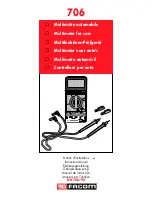
18 November 1996
Multiplexer Module (TX2A/TX4A)
MUX-17
4. Installation and Use of the 4 Channel Multiplexer Module
4.1 Power Supply
4.1.1 Supply Requirements
Note:
The Multiplexer must not be supplied by Switched Mode Power Supplies (SMPS). This
is because most SMPS operate at frequencies around 50 kHz. The harmonics of the
generated field can interfere with the TIRIS receiver. Therefore only use linear power
supplies, or SMPS with a fundamental operating frequency of 200 kHz or higher.
Noise from power supplies or noise on the interface lines can interfere with the RF Module’s
receiver. Therefore, if the application requires it, it may be necessary to place additional filters in
series to the supply and interface lines. For more details refer to RF Module Operating Manual.
In order to guarantee full RF Module performance, the power supplies should fulfill the
specifications for ripple voltage given in Table 7.
Table 7: Power Supply Ripple Specifications
Supply type
Maximum allowed
Ripple Voltage
Allowed Ripple Frequency
Unregulated VCL supply
30 mVrms
0 to 100 kHz maximum
(sinusoidal)
4.2 Antenna Requirements
The transmit antenna for the RF Module (which is used to charge up the transponder) is a coil
(see figure 3), this coil is part of the antenna resonant circuit of the RF Module.
In order to achieve the high voltages at the antenna resonant circuit and thus high field strength at
the antenna for charge-up (transmit) function, the antenna coil must have a high quality factor.
The recommended quality factor for proper operation is listed in table 8. The quality factor of the
antenna is decreased when the Multiplexer is used, a maximum resistance of 200 mOhms is
added per channel, which reduces the quality factor of TIRIS Standard antennas to about 55 (the
original quality factor is approximately 100).
For proper operation of the transmitter and receive function, the antenna has to be tuned to the
resonance frequency f_TX. For a detailed description of the antenna resonance tuning procedure,
see the RF Module Operating Manual.
To ensure that the antenna can be tuned to resonance with the connected RF Module, the antenna
inductance can only vary within the limits given in table 8.


































